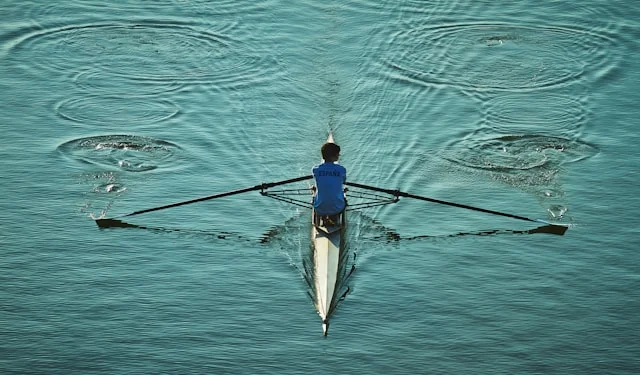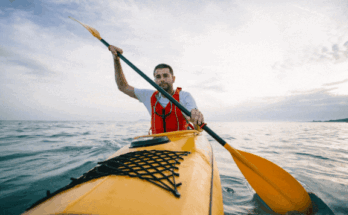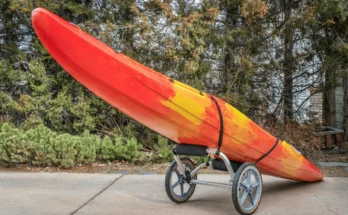Rowing Kayak and kayaking share plenitude in common – etc. However, both sports have variation, aside from the ones of the type.
In this article, we’re going to deliver a persuasive speech, giving reasons for a ridding of power vs. kayaking under the spotlight as one of the crews navigating these waters, I can study those differences up close.
It is quite common to see that when kayaking, one goes wrong by presuming that rowing kayaking and kayaking are the same sport with some new names.
Now additionally, today, our mission is to clarify for those who suppose they are alike that boxing and MMA are different sports instead, and we come with some of those main differences between them.
There will be a description of the sports and the personalities of people who are more likely to participate in these sports, as well as which water environment you can do each of them in the country.
It is evident that, apart from being the water sporting ingredients, these sports are also perfect for some outdoor exercising and having fun.
I have deliberately not included a detailed description of the rules and regulations of both sports. This will help you to recognize the skills and techniques needed, which will lead to a better decision on choosing your best sport. Let’s get into it!
What Is Rowing?
Rowing kayak is a means of transportation that’s had us rowing in water as far as we can remember. The source would probably be related to the enormous oars that were imperative for large boats and warships reaching far away places using a much larger labor force.
It is inherently understood that rowing kayak is generally competitive, you see, the sport came from England as far back as the 16th century.
Rich people would place bets on which of the rowers would reach London first and one day they cannot discontinue this sport anymore. Thus, rowing kayak is the sport we know today.

What Is Kayaking?
The way of kayaking is even 1000 years old, and some scientists believe that the Inuit people were the first to have this hobby.
Usually, the kayaks have from three to four persons in it and require paddling with alternative strokes of double-sided paddles. Kayaking can also be a competing water sport but it is more widely regarded as a popular leisure activity.
It is possible to transcend all the limitations of kayaking levels if a beginner prefers to stay at the slow waterway while the seas of rougher water might severely challenge those able to paddle.
There are certainly more amateur kayakers than the group who rows- although rowing kayak is generally simpler to teach and takes the learner a shorter time than canoeing, canoeing on the other hand is a recreational activity that one can easily socialize because of its nature of group competition.
The Major Differences Between Rowing and Kayaking
As such, there is a rather ‘vessel-like’ aspect to both these activities, and it is not the ‘oars’ that are particular about these two activities, so where is the main difference?
According to the saying, this is how it works in all the other spots you could mention.
Equipment
Kayak paddles are two-sided paddles ( there is one blade per end), whereas rowing kayak oars are one-sided blades with handle at one end and butts ( have rounded butts).
This is true because the one-sided movement of legs, required to move a rowing boat, differs from the one-handed kind of exercise.
On the other side, one is never doing a unilateral move in kayaking, as both arms are always in motion and you are keeping a paddle in each hand.
The design of a rowing oar depends on the origin in which it is fixed to the vessel using the oarlock (a kind of mechanism).
As kayak paddles are shorter because they are used to paddle on both sides unlike rowing oars as they are used for paddling on one side.
Technique
Additionally, paddling in kayaks and rowing kayak cabs consume the dominant upper body muscles. Correspondingly to define a stroke in kayaking, primary movement involves less motion as against in rowing.
Sitting very upright on a kayak which is ready to switch from one blade to another at any moment is in contrast to sculling, thus, technique varies.
The movement to which the rower belongs can be changed into two cases – he remains fixed to a bench or slides forward.
They mostly row backward in a competitor, which means they push with their legs and unfold the back to put as much power into each row while making sure not to weary themselves too soon.
Body Mechanics
Paddlesport and rowing level their playground in the line of forceful upper tonsils, Kayakers are on working of paddle stabilizing that;
Rowers are concentrating on speed in special. The kayak paddle motion usually includes the deltoids more than the other muscles as it is the part of the shoulder that is moved and held higher up with the paddle placed closer to the chest.
Rigging are the oars that are linked to a boat and much more force is needed from the back’s big muscles like the latissimus dorsi (pushing hard during the stroke as it is often done with two oars) In rowing, teams will work with the currents to gain the power necessary by using the momentum of the full leg movement and back rather than to go in big circular motions which are less efficient.
Frequently, the told will be extended to accommodate these sweeping movements.
Some of the strongest forces can be produced in kayaking by the legs but there’s also a component of balancing and controlling.
Risk of Capsizing
Extensively speaking, the possibility of capsizing on a kayak is higher as compared to that of on a rowing kayak—it’s particularly case for kayaks smaller than one man can afford.
Most recreational paddling falls well away from landing in the water, but as you step up your skills from basic to more advanced and technical kayaking, how to recover from an inevitable roll or fall is an essential skill to learn.
Small one or two-man row boats (even rowing kayak themselves) can be sunk to the extent of bad weather conditions, and the person in the water is sensitized to hypothermia if not rescued quickly.
But heavier one-man row boats are much less inclined to capsize and therefore safer for rowing kayaks in bad weather.
In addition, the risk is also closely linked on the quality of the vessel. For example, having harder to capsize inflatable canoe is better, unless you are on rougher water in which you can have the same risk as the other one.
Skill Development
The training and development component is a very important aspect of doing a rowing kayak vs kayak comparison. There are several advantages to using a rowing machine as training equipment.
It is a very common piece of equipment in gyms around the world. In this case, a rowing kayak machine can be a very helpful piece of equipment for a rower to train their stamina and technique. Different from skimboarding, mastery of kayaking skills takes time;
what’s more, not only do you need to know your water but also have some practice to gain in strength. Nevertheless, I think kayaking is slightly more scalable:
you can row as a beginner or as a professional, as you wish with a boat, in contrast to rowing which requires you to be fit to do it well, you can do it as easily as you like with a kayak.
Vessel Design
Whether kayaking or rowing kayak, all small boats have something in common, no substance whether they turn the boat over or not.
But the asymmetries, on the other side, are also striking. Rowing kayak are well longer and much narrower to achieve the characteristics of a sleek hull to obtain speed.
In the case of kayak vessels, there are a lot of variations – your run-of-the-mill kayak is shorter and wider – in trade for the ease of stabilization and balance during the change in water conditions Hence, getting a speed active kayak that is long and narrow for such events to happen.
Riders in kayaks will normally be seated in a position upright whereas the rowing Kayak with modern design are characterized by sliding seats that mimic the rowing motion.
Rowing Kayak vs Kayaking: Pros and Cons
Pros of Rowing
Rowing kayak has a lot of positive effects. At the forefront, here is a really superb adventure for all those sports-enthusiastic and determined people like Mr. Rocky Balboa himself who don’t miss the opportunity to build up their confidence while naturally moving with the beauty of nature.
Keep their eyes, for there are all kinds of contests for athletes of every caliber, and this is a very popular sport that is undying enough to have a diverse set of competitions; thus, there will be associated rowing competitions for the whole lifetime.
Rowing is fantastic cardio – the rowing exercise is the ideal cardio workout that will effectively engage the targeted muscles and keep your heart rate up no matter who you are.
The exercise of rowing is not only a great additional exercise for any sports guy or girl off-season program but can also add some variety to routine training.
As discussed here, rowing is a fascinating activity due to its numerous calories-burning properties. Caloric expenditure, according to Harvard Health, for a 155-lb person doing 30-minute intense rowing kayak is 369 calories – which makes it amongst the top calorie burners overall.
What is more, you need only a power machine to train – maybe you are just sitting in a gym using it.
Cons of Rowing
There can’t be a positive without a negative touch – this is the case with every element of our lives, and an identical connection can be found in rowing.
To start with, even rowing, which may be not so fussy, serious rowing can become noticeably tiring after some period of time.
What rowing as a training tool has, it does not make for a wonderful form of leisure activity, since it is the thing that makes it like so desirable.
You may do a leisurely bike ride or a walk, but there is no way of avoiding the movement constraints that the sport of rowing as such imposes on your body.
Lumbar spine area is most commonly affected by rowing given its high stress generating capacity hence the back.
Owing to the commencement and conclusion of the movement by respective back muscles and knee joints, the persons who continue to run for extended time are at the risk of developing lower back pressure and the case of wearing off the joint.
Lastly, rowing as a sport is highly repetitive and in that sense there is not so much variety in the movements and, consequently, it can be boring. If there were another sport that you would lose interest after only a few minutes into it, such as boring long bike rides, then rowing would also not be your sport.
Pros of Kayaking
Kayaking allows you to tap into its fantastic side. Moreover, kayaking is such a thing, which can be mastered by nearly anyone, because even a total beginner with the help of such affable professionals as the ones I learned from can grasp the basic skills in 15-30 minutes.
Kayaking makes us experience war with nature. A huge part of kayaking is about adapting to the water conditions – some days can feel really easy breezy with the water smooth as silk or very relaxing in calm waters, but in situations where things get difficult, it forces you to pay attention and be in the moment.
Flowing seems to be a prominent trait of most people confronted with such a challenge and, besides, it’s a diversion as the dictionaries say. You could engage with kayaking on your own or with friends.
In fact, the social side of kayaking attracts many people and you can determine the pace that suits you better – be it a laughing and relaxed day with mates or something a little more competitive.
However, the ultimate goal of kayaking is just to spend a happy and great time with the people you love the most. Through the use of kayaking, you can at the same time get relaxed – it is an activity not so exhausting and that’s great! Provided that you are thorough when reading reviews and selecting simple rivers, kayaging will definitely end up producing benefits for you in terms of mental health.

Cons of Kayaking
If sunshine is all we get, paddling and that’s why I begin with this. First. Kayaking in particular can be classified as a sport, often determined by the weather, of all levels and beginners especially.
The activity may be ruined if local hotspots are destroyed by the high wind, which can take only few minutes to change a hangout where you can enjoy the zero gravity as well as the calm and relaxing feelings.
One kayaking is usually better for beginners while rowing but it becomes more dangerous if you focus on harder form of kayaking which is white water kayaking – a notch higher.
There’s the factor of skillsets and strength that is needed for you to build, and this can be an intense step that cannot be easily handled on your own.
Therefore, we narrow down to our third disadvantage – although kayaking is quite simple to start, the more challenging events are just as complicated as they are to become part of.
If none of your friends want to invest much beyond a bizarre kayaking, when do you dig your own paddling in?
At the start, novice kayakers are advised with extra care, unless they are accustomed to whitewater kayaking already, and there is also a huge learning curve involved in the process.
Notably, one significant disfavour of newly becoming a kayaker is that you gain an unwarranted level of courage.
Overstepping your own boundaries in kayaking makes it much easier to get yourself in a difficult situation – for example, because of its lack of demand, if you go too far out and get lost you can also find yourself in trouble.
Is Rowing Faster Than Kayaking?
Yes, utilizing the rowing kayak will decrease the total time of the journey. Larger oars and vessels with more or less speed in mind are the advantageous facilities.
Race time on rowing finals tends to be more than on the kayak events, which eventually may not give fair chance to the competitors, but normally everyone is faster.
Faster is more desirable for heterogeneous transport, and a ship should get from A to B as quickly as possible.
Similarly, there is an explosion of the “high-performance” kayaks coming out of gear making companies, but the rowboats that are maximized for speed still have the upper hand.
Is Rowing or Kayaking Better for Your Back?
Ultimately, kayaking wins in this case through using the power of water, rather than motion, as a driving force. Small lighter of kayak works also the same muscles as in rowing but the intensity is different. Strange rowing method,
including the lumbar spine (lower back) strain, might give a start to back pain and problems as well. The difference between kayaking and paddling is apparent in a more gentle swooping, not really notching that particular spot on your back which is typical of a forward bending position.
Is Rowing Easier Than Kayaking?
Of course, it is up to you the same is true for the professional levels both sports require a lot from their players. Rower until even the best athletes may bear the stamina.
On the other hand, these rowers will use the most powerful muscles belonging to the body. However, high-level kayaking takes a lot of skill and time to master.
When speaking of comfort –it is undoubtedly easier to pick kayaking over sailing for a unskilled person. You could even find this strange to understand that rowing is an activity that is performed relatively at the same motion for long period.
What you may not know is that it will take comparatively more coaching than you think to do this properly.
Rowing vs Kayaking: Hips, belong to the Shin, sports soccer and basketball as well as ankle injuries.
There is a great deal of accident between recent injuries that occur in kayaking and those that occur in rowing. The most average of these include:
- Back and knee problems
- Wrist problems
- Shoulder sprains and injuries
Back and knee difficulty, as well as anything else that is closely connected with this sport can sometimes be a struggle for athletes who take part in the rowing sport a lot.
Kayaking is known mostly because of the wrist injuries that only happen due to the wear and tear by the repetitiveness of the movement.
In the event of more precocious kayaking, shoulder sprains are also very common as well are muscle injuries, which are other very well-known injuries in kayaking.

Rowing vs Kayaking: Which Is More Expensive?
In a sense, rowing as a sport is strong – the cost to cover the care fee for boats is a heavy burden. It takes ages to get the necessary rowing method and skills, when you stop the practice then you can lose it in the blink of an eye.
The membership fees is too expensive and only if you live in other areas you can afford them.
Because kayaking is much cheaper and more convenient, it is always the first choice of young people, who are looking for adventures.
To cut the costs, pre-owned kayaks in standard shape are basically about a couple hundred bucks, and might be used for lifelong workout, if they are in good shape.
The higher the applied science level you want to reach, the higher is the costs you have to pay. On the leg, kayaking as a beginning option is less expensive.
Conclusion
Paddling and rowing—which are alike in a few views—would then be highly contrasting in status of the essential elements.
Nonetheless, I like both of these activities even though they are very different. The choice of the best-suited act depends on you, and your attribute, and nothing more.
We hope the information here has been useful to you and please comment if you have any more insights into the rowing kayak vs kayaking analysis.
Give this article a share if you think someone would enjoy or benefit from the information here.






Thank you for every other informative site. Where else may I get that kind of info written in such a perfect manner? I have a undertaking that I am just now operating on, and I’ve been on the glance out for such info.